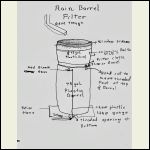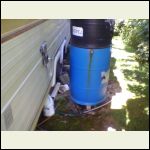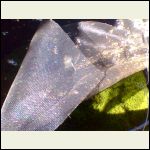|
| Author |
Message |
ackersandy
Member
|
# Posted: 14 Aug 2016 07:07pm - Edited by: ackersandy
Reply
I currently have water delivered (expensively) to my year-round cabin, to an 1140 gal pillow tank with a pump and pressure tank. I use this water for everything except drinking/cooking. I am about to hook up a rainwater catchment system from my roof gutters directly into the pillow tank. There will be a filter, but nothing fancy-- just a debris filter. I am concerned that over time this unfiltered, untreated rainwater will make for nasty conditions inside the tank, which is impossible to clean out. Comments? It looks like most folks use rainwater just for watering gardens and such, not for storing in a cistern for indoor plumbing.
|
|
Julie2Oregon
Member
|
# Posted: 14 Aug 2016 07:41pm
Reply
Cool that you're using a pillow tank!!! That was my first choice when I was going to be relying on a cistern. The suppliers I looked at buying it from provided cleaning instructions so I didn't think it was impossible but it would involve disrupting your water supply briefly.
But I don't know how safe it would be to bathe in water that's just gone through a debris filter from your roof. It will likely have been in contact with bird poo up there and such. Can you rig up at least a sand or charcoal filter tank between your gutter and pillow tank to do a better job of filtration and then add some bleach to the mix?
Just some thoughts.
|
|
Just
Member
|
# Posted: 14 Aug 2016 08:22pm
Reply
This filter and tank have been in use since 07 never been touched or cleaned . We use the water for everything we boil it before drinking . we add a tablespoon full of bleach once a week to the tank " not the filter ". there is a natural occurring green moss that grows, on the top of the filter sand , from what I read it helps with the filtering .IF I had to change any thing I would add a first flow diverter .
filter
| 
drained in winter
| 
green moss
|  |
|
|
bldginsp
Member
|
# Posted: 14 Aug 2016 08:45pm
Reply
It's best to use a first flush diverter with any rain catchment system. After weeks of no rain the roof is dirty with dust and bird poop. The first flush of water off the roof at the next rain is dirty and you don't want it in your tank. A first flush diverter diverts the first few gallons away, then allows the subsequent clean(er) water to flow through to storage.
Google Texas Rainwater Manual for good info.
You can use a debris filter, but if you filter it at the gutter this is unnecessary. I used 'Gutter Glove' brand gutter screen which is expensive but strong enough to walk on and has a fine mesh stainless filter.
I've been collecting rain water for 5 years or so doing this and the water isn't yucky, but I wouldn't drink it. I shower with it and it is so soft it feels great. And I was dishes with it. Never gotten sick. You can always shock the tank with 10-20 parts per million chlorine, though 4 ppm is a municipal standard.
|
|
Julie2Oregon
Member
|
# Posted: 14 Aug 2016 10:32pm
Reply
Just
That's a really neat system!!!
|
|
Just
Member
|
# Posted: 14 Aug 2016 11:16pm
Reply
IT'S important to filter the water before storage .goes in clean better chance to come out clean .
|
|
creeky
Member
|
# Posted: 15 Aug 2016 11:43am
Reply
Google some of the Australian rain water docs. They don't think much of first flow devices. though I figure, jeez, it can't hurt.
Just's system is ideal. you want that 50lbs of sand with the green algae. The algae actively eat bacteria. The sand removes all kinds of bad stuff as well as the dirt.
There is a great doc on water treatment done by the UN. Dang. Can't remember where. If you find it. You might post the link? But it reports on the benefit of sand prefilters for rainwater in "potable" water systems.
I copied Just's system for my rain water catchment. My barrels are a bit bigger tho.
|
|
ILFE
Member
|
# Posted: 15 Aug 2016 04:12pm - Edited by: ILFE
Reply
Just or creeky,
How heavy of a downpour can the filter handle before it overflows?
I too, use a first flush on my Rainwater Harvesting System.
|
|
|
ILFE
Member
|
# Posted: 15 Aug 2016 04:25pm
Reply
Quoting: creeky There is a great doc on water treatment done by the UN. Dang. Can't remember where. If you find it. You might post the link? But it reports on the benefit of sand prefilters for rainwater in "potable" water systems.
I tried to locate it, but failed to do so.
http://www.unwater.org/publications/en/
|
|
Just
Member
|
# Posted: 15 Aug 2016 04:38pm
Reply
Sorry, I have never watched . We have a 10 x 24 roof . We have never ran out of water but we don't use a lot.
|
|
bldginsp
Member
|
# Posted: 15 Aug 2016 04:46pm - Edited by: bldginsp
Reply
Page 34
https://www.slideshare.net/mobile/D6Z/r3b292
Evidently there are many commercially available sand type filters available. I'd research it well before I did it though, because if improperly done it could become a breeding ground for bacteria along with a trap. I think the commercial ones are capable of back flush to rinse them out periodically.
A quick google turned up a lot of results for "how to make a sand water filter."
|
|
creeky
Member
|
# Posted: 15 Aug 2016 11:03pm
Reply
schmutzdecke is one of the Google words.
Biosandfilter.org
http://www.cdc.gov/safewater/sand-filtration.html
some.many posts here at s-c.
After seeing the Biosandfilter.org info I might revisit my implementation. Been a very dry year and i've been using the well as a result.
|
|
DaveBell
Moderator
|
# Posted: 16 Aug 2016 01:32am
Reply
http://www.small-cabin.com/forum/3_6657_0.html#msg98014
|
|
ChuckDynasty
Member
|
# Posted: 16 Aug 2016 07:26am
Reply
Quoting: Just drained in winter
Quoting: Just there is a natural occurring green moss that grows, on the top of the filter sand
Does the moss survive the winter?
|
|
Just
Member
|
# Posted: 16 Aug 2016 09:13am
Reply
Quoting: ChuckDynasty Does the moss survive the winter?
yes, we are in southern Canada .43 parallel .
|
|
ILFE
Member
|
# Posted: 17 Aug 2016 01:39pm - Edited by: ILFE
Reply
Quoting: creeky After seeing the Biosandfilter.org info I might revisit my implementation. Been a very dry year and i've been using the well as a result.
Not sure if this may interest you, or others here. It's a list of materials I got from Centre for Affordable Water Sanitation Technology (CAWST). The types of slow sand filters you posted are fairly common, here in Cambodia.
Link: Water Resources on my DropBox account
Two of the best resources in that list are:
eBook 1: BSF Mold Welder Picture Book
eBook 2: BSF Construction Manual
|
|
creeky
Member
|
# Posted: 17 Aug 2016 02:16pm - Edited by: creeky
Reply
Thx ILFE.
I am doing it wrong. I only have sand. And a big fat strainer. Well. I am using a repurposed used pool filter. Rather than the long thin strainer shown in the doc.
The doc even has nifty graphics about what happens to the bad bacteria.
Here's the link to the doc as found in ILFE's water resource account.
and I recommend to anyone doing off grid water. have a look at the cawst site. cool.
gosh. and they're canadian. imagine.
|
|
ILFE
Member
|
# Posted: 18 Aug 2016 06:14am
Reply
I feel a bit slow after reading this thread. It never crossed my mind to build a sand filter on a much larger scale, than those concrete sand filters.
And to think, I have had many of those files since February of last year! Geez, being born a blonde has certainly not helped me through life, has it? :D
|
|
Ontario lakeside
Member
|
# Posted: 18 Aug 2016 03:01pm
Reply
We only screen for debris for our 500 gal tank. I add 1/2 a chlorine pool puck once a month. We only use it for showers and dish washing. Im not overly concerned with a bit of contamination. The chlorine will kill most of it. We swim in the lake and it gets bird, fish, snake, beaver etc. poo. 
|
|
|

